How to Draw a Dog How to Draw a Realistic Baby Panda
How to draw a dog
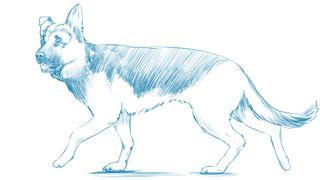
Today'southward tutorial will testify you how to draw a dog. The skeletons of dogs and cats are quite similar, especially in the simplified version drawn here. Just it'due south important to remember that these animals movement differently and look very different from each other.
This tutorial volition take you through the step-past-step process of how to draw a dog. Nosotros will exist sketching an anatomically correct portrait of a German language Shepherd. This volition start with sketches and move on to drawing the skeleton, muscles and fur. By the end, y'all'll be drawing a domestic dog with ease. For more advice, take a expect at our roundup of tutorials exploring how to draw animals.
01. Observe in quick sketches
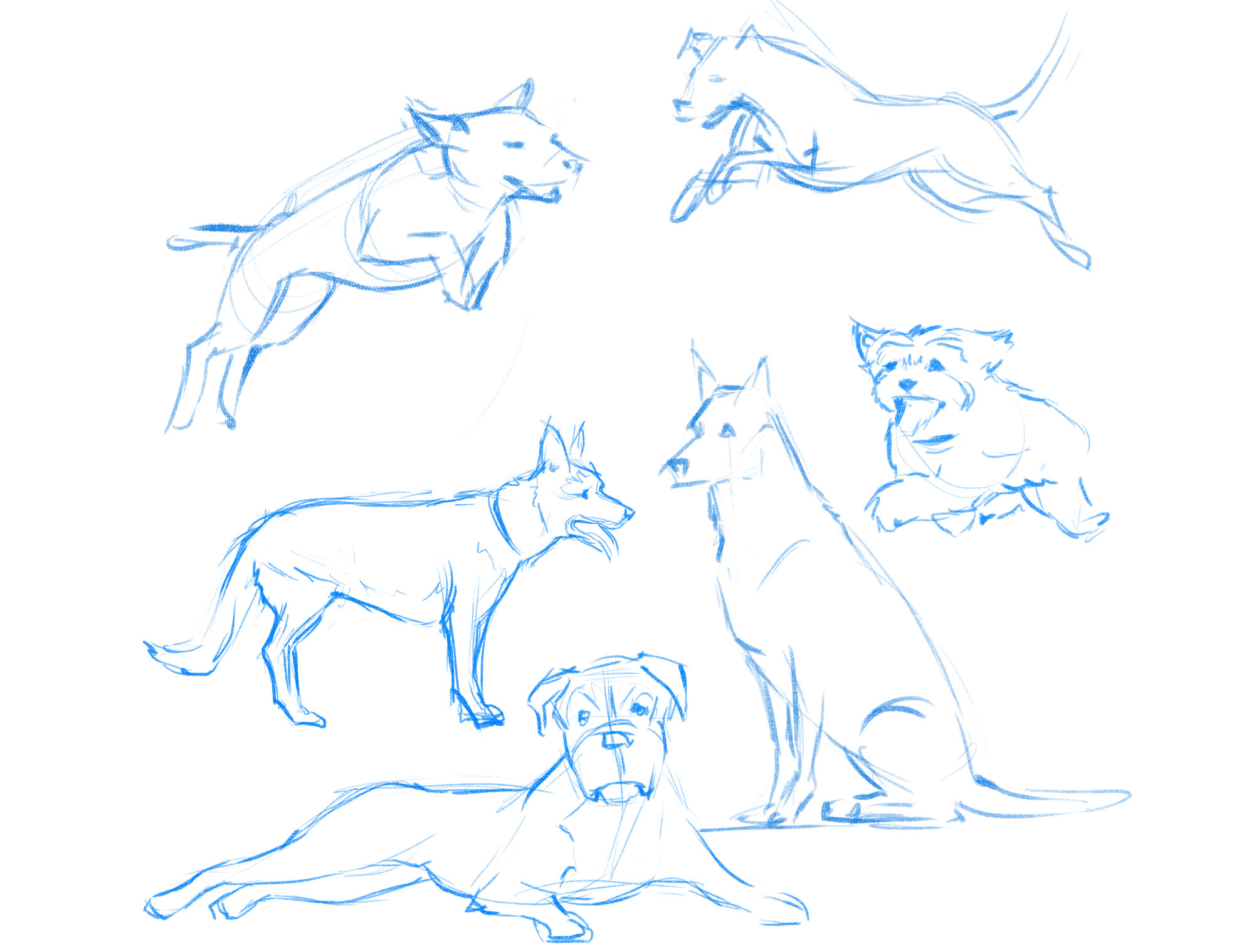
Many people – especially those who are new to art – disregard the sketching phase and consider information technology a waste of time. Often they will draw one or two sketches and call information technology a solar day. It's very piece of cake to be tempted to speed up this phase. After all, details are much more than fun to draw, aren't they?
The problem is, if we're also eager to become to the details, it's easy to ignore the overall anatomy. And trust me on this: beautifully rendered fur on a beast that only partially resembles a canis familiaris will impress no i.
If yous own a dog yourself, observe how they walk, run, jump, sit or lie down. You may recollect you know how they move, but you really won't until y'all consciously observe the brute. You tin can also google some photos of dogs and utilise them as reference to quickly sketch different poses. Endeavor not to spend time on details – the sketching phase is not about that.
02. Detect the skeleton
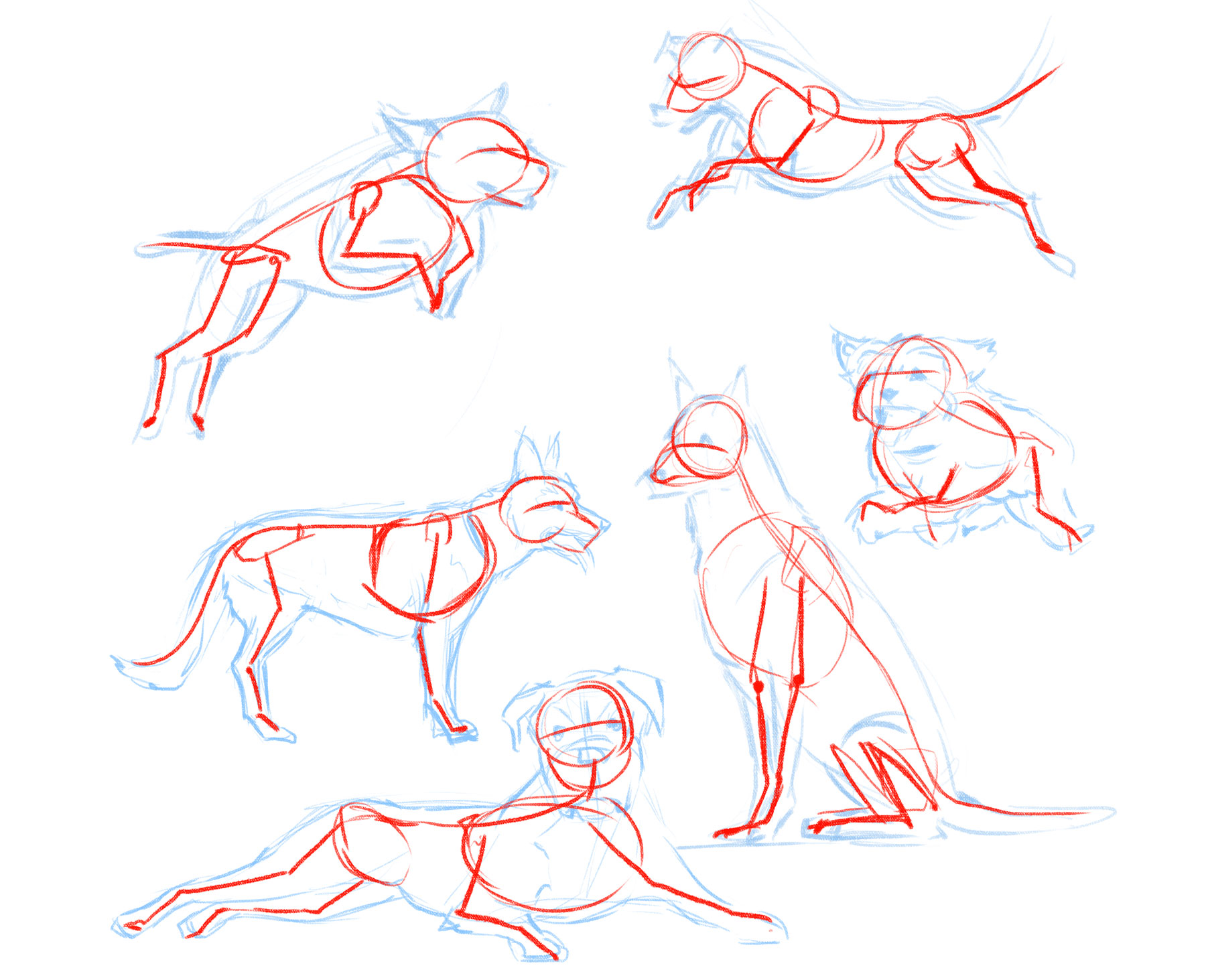
Focusing on the skeleton is a fundamental part of mastering how to draw a dog. Even though in the end no 1 is going to see it, information technology'southward essential to understand the skeleton and be able to depict it in proportion. Equally y'all get more good you may kickoff cartoon the skeleton more loosely or perhaps fifty-fifty be able to skip this step altogether because by then the proportions will be engraved in your memory.
Earlier you movement on to drawing the skeleton in your chosen pose, a skilful do would be to draw the construction on peak of your previous quick sketches. This will help yous become more familiar with the idea of a skeleton underneath all that cute fur that dogs are covered in.
03. Draw the skeleton
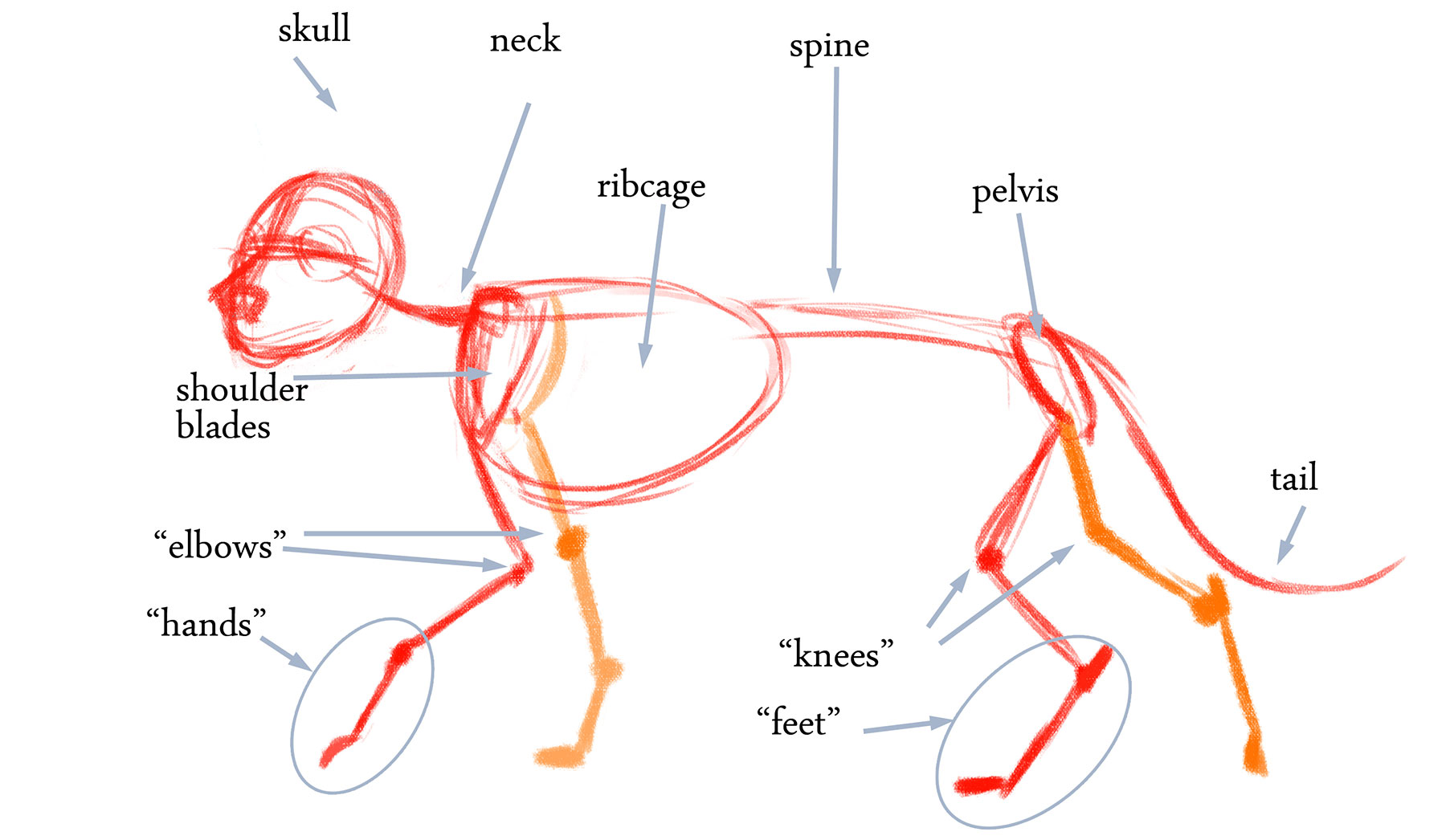
Equally you sketch dogs in different positions y'all volition soon realise which one appeals to you lot the most. Mayhap you'll choose to draw a dog napping, or sitting. This tutorial will apply a walking pose as this shows the animal and its anatomy in the all-time possible mode.
Loosely draw the skeleton of a dog in your chosen pose. A good tip is to describe the skull, ribcage and pelvis bone, and employ single lines to indicate the spine, tail and limbs.
Dogs' skeletons have many similarities with homo skeletons. You can conspicuously see the equivalent of man knees, elbows, anxiety and hands. Dogs' legs are not that dissimilar from our arms and legs – the only existent difference is in the proportions of the bones.
If you look closely you'll encounter that dogs walk on the balls and toes of their feet, sort of like a woman in high heels. Notice how opposing front end and dorsum legs carrying nigh of the weight of the domestic dog. They are firmly placed on the ground, while the other two barely touch the floor.
If you work in traditional media, employ very light strokes for the skeleton, so that you can erase it subsequently. If you piece of work digitally, draw each step on a separate layer.
04. Draw in the muscles

The point of this stride is to establish the anatomy below all the fur. High german Shepherds are not particularly fluffy, so the muscles will be visible through the outer coat. However, if you choose a brood such every bit an Afghan Hound or Bernese Mountain Dog you'll face a slightly bigger challenge finding the muscles under all the fur.
Information technology is important to understand how the muscles sit down under the pare. Understanding the general rules will requite you lot the tools you demand to describe any domestic dog, regardless of the pilus length.
05. Focus on the face
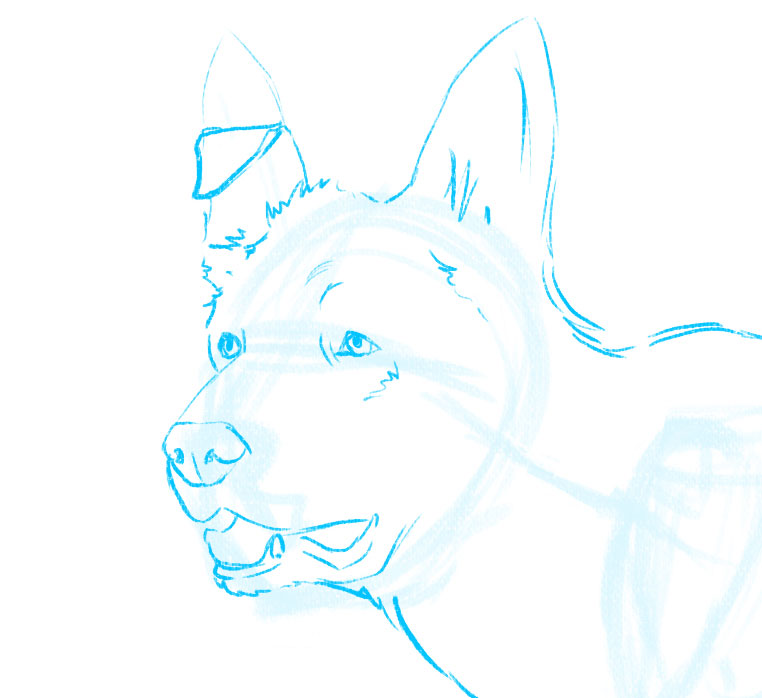
Now it's time to refine the drawing, beginning with the head. We desire to beginning using stronger, more decisive lines at this point.
Information technology's very of import to observe the correct position of the eyes. If you're cartoon a canis familiaris's head direct-on, information technology'south fairly easy to maintain the correct proportions betwixt the eyes and nose. Nevertheless, drawing the face in a slightly turned view can be much trickier. Not only are the eyes at present at a dissimilar bending, which changes their shape and size, merely their position in relation to the olfactory organ likewise changes.
It'due south important to call up that the eye that is further away from the viewer will non exist the same size as the one in the foreground. Perspective ways the closer eye will be slightly bigger.
06. Draw in the cage
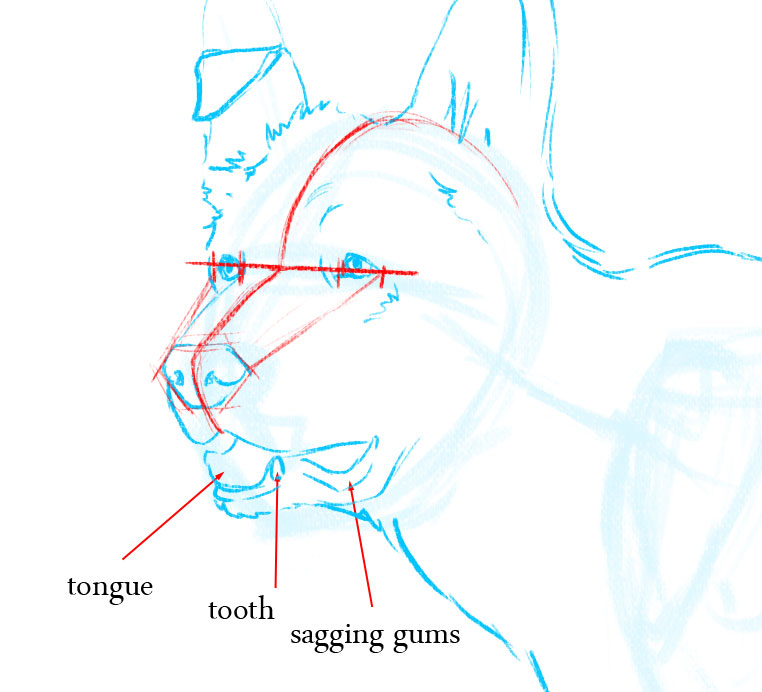
Similar many other dogs, German Shepherds have quite long muzzles. Even pugs, which don't have prominent muzzles, don't take entirely flat faces. The length of the domestic dog's cage will vary depending on its breed, so make sure to observe this carefully.
Making the muzzle too long or likewise short will drastically modify the likeness of the dog. Remember that in a iii-quarter view, the cage will announced shorter.
Pay shut attention to the shape and size of the nose besides. Most dog's noses look quite similar, just depending on the breed they tin be bigger or smaller in relation to the rest of the caput. If the canis familiaris has an open mouth they volition ordinarily evidence their teeth, gums and tongue, which is typically quite long and flexible.
07. Move on to the ears
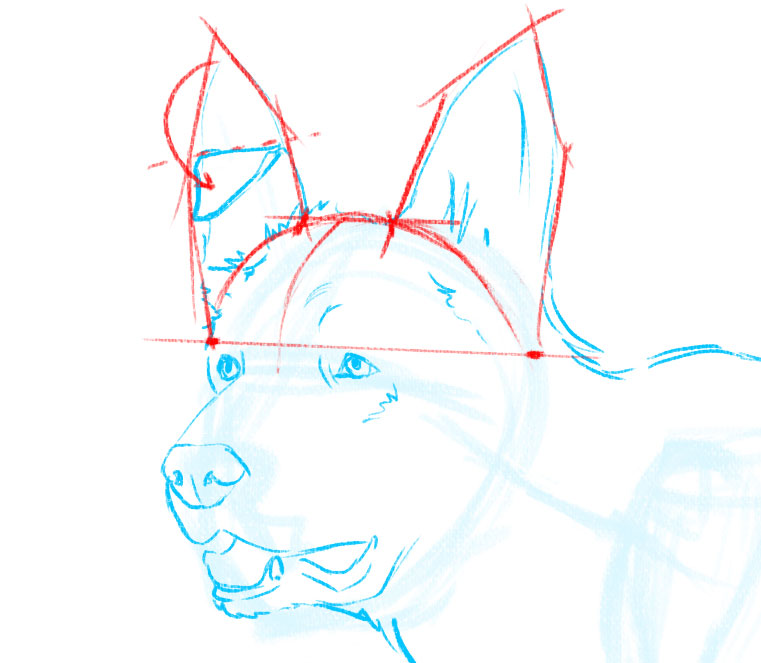
Equally with the eyes, it is necessary to pay shut attention to perspective when drawing ears. Observe the shape of the caput and how the ears are attached to it. The ears are mostly a mirror prototype of each other, only fifty-fifty when painting uneven ears (some dogs have ane droopy ear, for example) they will stay a consistent shape at their base. In this example one of the ears has been altered on purpose as an example
08. Refine the trunk
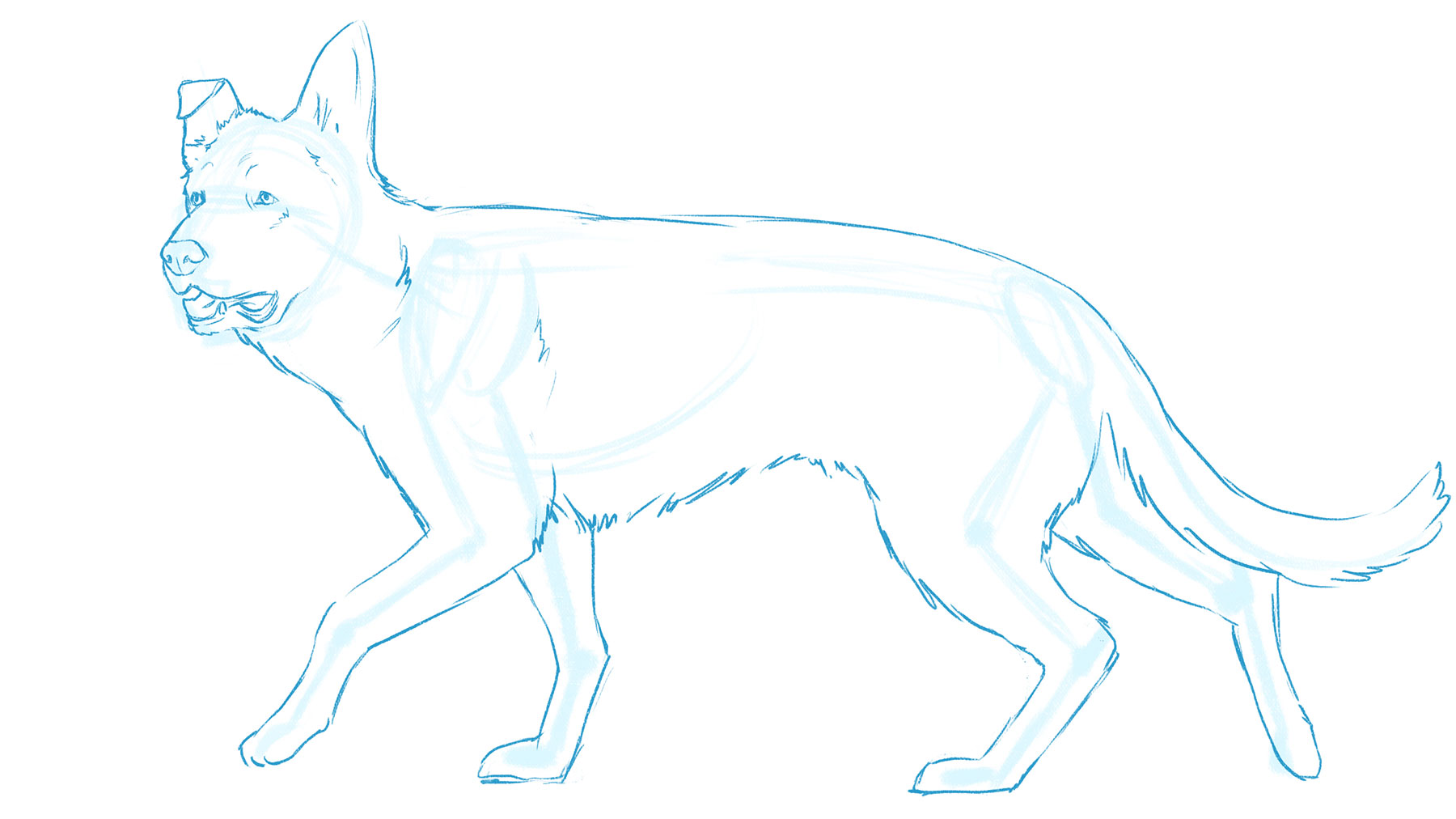
We already take a good idea of the musculature of the body, but on peak of the muscles in that location is pare and fur. In some cases this tin drastically change the look of the dog (think about how different sure dogs can await subsequently they've been clean-cut).
German Shepherds are withal hairy in places, so where necessary use smaller strokes to indicate fur. The domestic dog we're cartoon has thicker fur around its cervix, under its abdomen and on its tail, simply on the remainder of his body, especially the caput and legs, his hair is shorter. Avoid using the same kind of strokes all over unless it'south a short-haired brood.
When you're done, erase the underlying lines if working traditionally or turn off the skeleton/muscle layers if you're working digitally.
09. Consider fur patterns
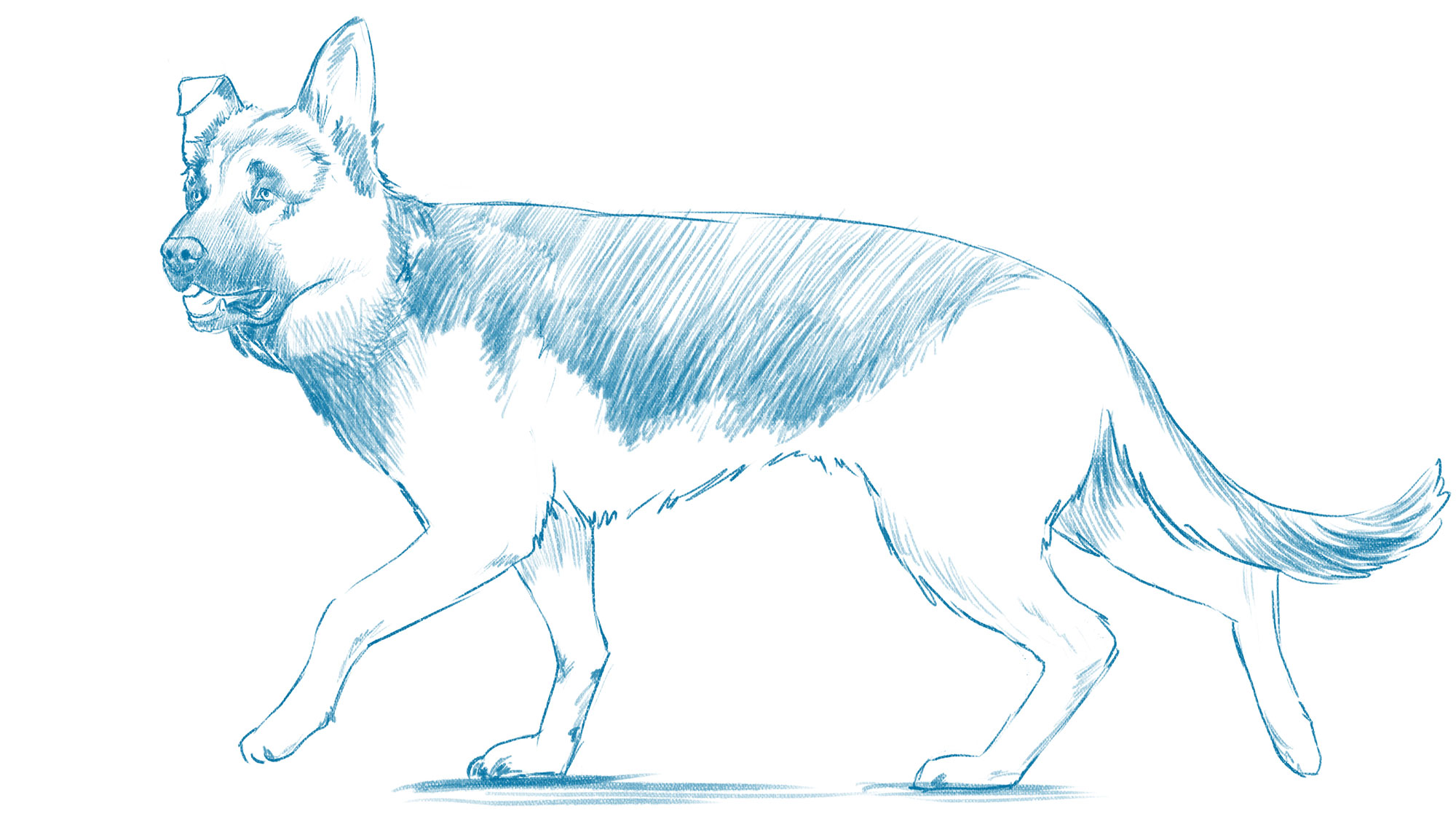
Every dog is a footling different, and their colours tin can vary greatly. This can still be shown even in a black-and-white sketch. Use varying pencil strokes when shading to ensure the coat pattern doesn't expect flat.
This dog's hair is mainly brown and black. Information technology's not necessary to recreate all of the tonal values, so instead y'all could sketch in simply the black parts of the fur. A good tip is to utilize lighter strokes along the dog's back to indicate a low-cal source hitting the fur.
ten. Add final touches

Finally, add some subtle strokes forth the dog's legs to give a suggestion of muscles showing underneath the fur. The idea is to convey enough information to give the dog character without having to shade the entire silhouette. The final touch on is to add some shadows under the paws and voilà – you drew a domestic dog!
If you lot want to larn more, yous could check out how to depict a pencil portrait of a domestic dog or observe a guide to cartoon a dog's musculus groups.
Read more than:
- The best pencils for colouring, cartoon and sketching
- How to describe: The all-time drawing tutorials
- The 12 best drawing books
Related manufactures
Source: https://www.creativebloq.com/how-to/draw-a-dog
0 Response to "How to Draw a Dog How to Draw a Realistic Baby Panda"
Post a Comment